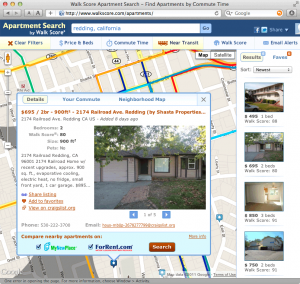Difference between revisions of "Walk Score"
Rabiabonour (talk | contribs) |
|||
| Line 18: | Line 18: | ||
[[Category:GTFS-consuming applications]] | [[Category:GTFS-consuming applications]] | ||
[[Category:Map applications]] | [[Category:Map applications]] | ||
| + | [[Category:Travel time maps]] | ||
[[Category:Data Visualization applications]] | [[Category:Data Visualization applications]] | ||
Latest revision as of 08:06, 25 January 2017
Several apps that visualize a transit system by leveraging the GTFS data format are available.
Walk Score [1] is a website created by the not-for-profit organization Front Seat (Figure 5). The purpose of the website is the help people quantify “walkability” through a numerical score. “Walk Scores” indicate the number of nearby amenities that are within walking distance. Walk Score’s primary use has been for buyers of real estate who wish to convenience access to amenities. Walk Score is also used by people selecting an apartment or home to rent. In mid-2012, the travel booking site Hipmunk [2] added a “Walk Score” layer in its hotel mapping feature. This allows travelers to discover and select hotels that are located in convenient areas of a city.
In August 2010, Walk Score incorporated Transit Score and commute reports [3]. According to the Front Seat press release, “Transit Score provides a 0-100 rating indicating how well an address is served by public transportation. Ratings range from ‘Rider’s Paradises’ where multiple transit options are available within a quarter of a mile to areas with limited or no nearby public transportation.”
Also in August 2010, Walk Score began offering a Public Transit API. According to Front Seat, “With the Public Transit API, real estate and other website owners can show nearby public transit stops on a map, show a text description of nearby transit stops and routes, and show the Transit Score of a specific location.” [3]
In September 2011, Walk Score added a feature called “Apartment Search.” The feature allows its users to see apartments and house rentals listed in Craigslist within a given transit commute time of their work or school. In addition, a “Near Transit” button allows the user to see all properties that are within a given distance to a transit stop. When this filter is turned on, transit routes appear and the area with a specified proximity of stops is highlighted.
Applications such as Apartment Search and Walk Score can help induce more regular ridership. These applications helps transit agencies’ target customers (whether discretionary riders or transit-dependent riders) locate themselves in such a way that they’ll become more inclined ride transit frequently. These applications can help a community to value transit service and walkability. Real-estate agents can also use these resources with their clients to emphasize properties that are easily accessible via walking or transit.
It is recommended that transit agencies link to Apartment Search from its website. This will help customers locate themselves in a way that provides convenient access to transit services. This may help to provide residents more mobility options, increase ridership and fare box returns, and/or reduce demand for dial-a-ride services. It is also recommended to integrate Apartment Search into “travel training” programs, or one-on-one instruction for riding public transportation, if they exist. Walk Score uses public GTFS from GTFS Data Exchange [4]. It is cost-free for transit agencies to participate.
References
- ↑ Walk Score. "Walk Score (R)." Accessed August 1, 2012 from http://www.walkscore.com/
- ↑ Hipmunk, Inc. "Hipmunk." Accessed August 1, 2012 from http://www.hipmunk.com/
- ↑ 3.0 3.1 Aleisha Jacobson. (2012). "Walk Score(R) Launches Transit Score(TM) and Commute Reports." August 16, 2010. Accessed: from http://blog.walkscore.com/wp-content/uploads/2010/08/Walk_Score_Launches_Transit_Score_16Aug10.pdf
- ↑ Jehiah Czebotar. "GTFS Data Exchange." Accessed August 1, 2012 from http://www.gtfs-data-exchange.com/
